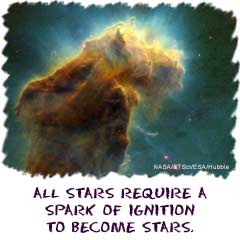|
|
||||||||||||||||||||
 |
|

|
||||||||||||||||||
What Makes a Star? We emphasize the basics at Cosmos4Kids. You're here to learn about what a star is and a little bit about them. Once again, a star is basically a ball of gas that has nuclear reactions occurring in its atmosphere. As those reactions occur, huge amounts of energy are released into space. The energy is released as electromagnetic radiation (EM). That EM radiation includes visible light, UV (ultraviolet) light, IR radiation (infrared), x-rays and gamma rays. There are also very small particles leaving the star. Those particles are byproducts of the nuclear reactions.
We emphasize the basics at Cosmos4Kids. You're here to learn about what a star is and a little bit about them. Once again, a star is basically a ball of gas that has nuclear reactions occurring in its atmosphere. As those reactions occur, huge amounts of energy are released into space. The energy is released as electromagnetic radiation (EM). That EM radiation includes visible light, UV (ultraviolet) light, IR radiation (infrared), x-rays and gamma rays. There are also very small particles leaving the star. Those particles are byproducts of the nuclear reactions.
ColorsWe have a yellow star. That's the Sun. Some systems have red stars. Others have a blue tint. The color of a star depends on its surface temperature. Bluer stars have a higher surface temperature. Lower temperature stars give off a lot of red light.The Three BasicsAstronomers look at three main characteristics of stars. They study luminosity (brightness), temperature, and radius (size). Each of these three factors can tell you a lot about a star. Take our star for example, the Sun. As far as stars are concerned, it is rather small. The yellow color tells you it has a nice, medium temperature. The small radius also gives an indication that it not much of a powerhouse. Last is the luminosity. On Earth, the Sun may seem bright. Compared to other stars it is only a candle. Astronomers consider our Sun to be in the main sequence of its development. |

|
|||||||||||||||||||
Useful Reference MaterialsEncyclopedia.com (Stellar Magnetic Fields):http://www.encyclopedia.com/topic/Stellar_magnetic_fields.aspx Wikipedia (Stellar Kinematics): http://en.wikipedia.org/wiki/Stellar_kinematics Encyclopædia Britannica (Molecular Clouds): http://www.britannica.com/EBchecked/topic/151690/molecular-cloud | ||||||||||||||||||||
|
RETURN TO TOP or Search for more information... * The custom search only looks at Rader's sites. |
|||||||||||||||||||
©copyright 1997-2015 Andrew Rader Studios, All rights reserved. Current Page: Cosmos4Kids.com | Stars | Requirements |
||||||||||||||||||||
|
|
||||||||||||||||||||

